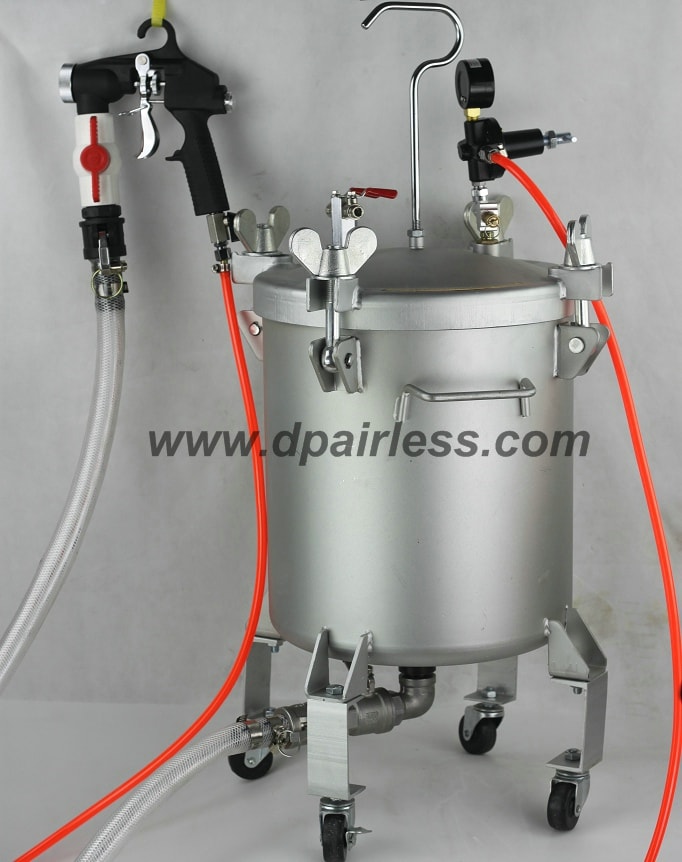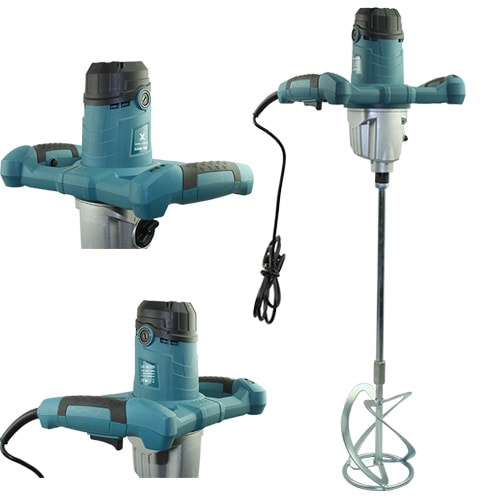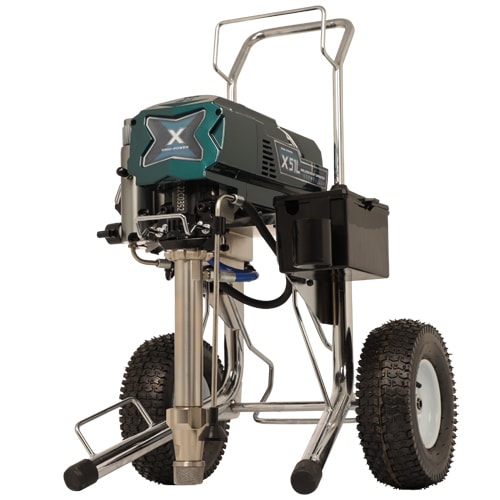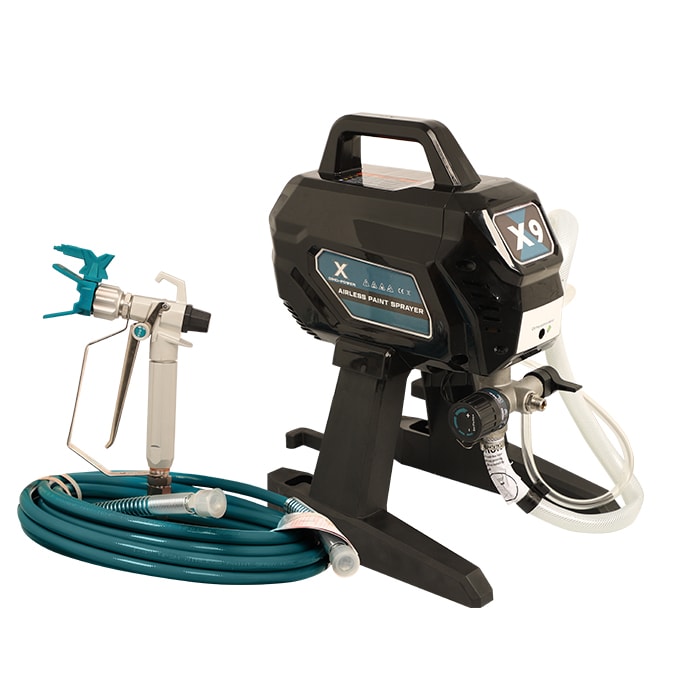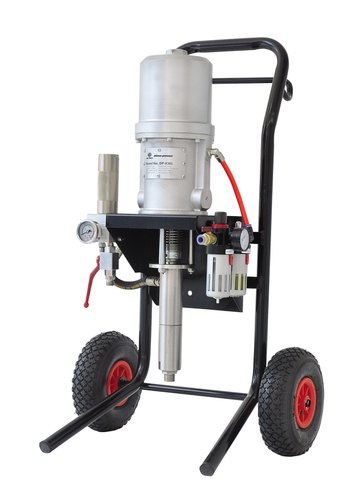Airless Spraying technique
Safety First! Read about airless spray painting safety
In any airless spray application, a careful study to determine correct spray techniques for each work piece configuration can save both time and material.
- Operator Technique
- Gun Position and Movement
- Work Piece Configuration
A balanced combination of these three factors will generate the best finish quality, with the least effort and the lowest cost.
Operator Technique
Gun Position
Hold the airless spray gun with a firm, but comfortable grip. Use the index and middle fingers to trigger the spray gun. The gun should be a natural extension of the operator’s arm. There are both two and four finger spray guns.
Hose Position
Hold the gun in one hand and the fluid hose in the other hand.
When using long hoses or when more flexibility at the gun is needed, a small “whip-hose” hose can be installed between the end of the supply hose and the gun. The whip-hose will allow the operator to move more smoothly during the spray stroke.
Body Position
There are no set rules for body position, but here are some recommendations. While facing the part, stand with your legs a little wider than shoulder width. Pull the leg opposite the spray gun back slightly. Use the forward foot to pivot during the spray strokes.
Gun Movement and Position
Distance
The fan angle and orifice size of an airless tip affect the spray pattern. Gun tip distance from the work piece being sprayed also affects the spray pattern. As the gun distance from the part increases, the fan width becomes wider, eventually causing and overspray condition and uneven coverage. A gun distance of approximately 12″ produces the best coverage. If the 12″ distance must be exceeded, select a narrower fan width to retain your efficiency. All airless tips are sized at the 12″ spray distance.
Gun Position
Hold the gun perpendicular to the surface whenever possible to reduce the chance of uneven paint coverage. Tilting the gun either up of down will produce a heavy build-up of paint on the top or bottom of the spray pattern. Arcing the gun causes a heavy coverage of paint on the left and right side of the pattern. Both arcing and tilting the air spray gun also causes an
angle at which the paint can bounce off the work piece surface.
Triggering
Triggering the gun controls an airless paint system. The gun is either “full on” or “off”, there is no partial triggering or feathering. Timing the triggering movement is key to an even paint coverage on the part. The gun stroke or movement should be started before triggering, and release the trigger before the stroke ends. This method provides a “lead and lag” for more
even coverage. Proper triggering also conserves paint and prevents excessive material build-up at the beginning and end of each stroke.
Overlapping
If the first stroke is begun on the left side of the work piece, the gun is moved down at the end of that stroke and the second stroke begins at the right side. A means of judging the amount of overlap is aiming the spray gun directly at the bottom of the previous stroke. As spray technique experience becomes more effective, the amount of spray overlap will be reduced, increasing the efficiency.
Spray Speed
The proper spray speed applies a full wet coat application with each stroke without sagging. If the desired film thickness cannot be obtained with a single pass because of “sagging”, then two or more coats can be applied with a flash off period between each coat. The spray movement should be at a comfortable rate. If excessive spray gun movement is necessary to avoid flooding the work, then the fluid tip orifice is too large or the fluid pressure is too high. If the stroke speed is very slow in order to apply full wet coats, then the fluid pressure should be increased slightly or a larger tip be used.
Overspray
Overspray depends on a lot of things; tip size, tip condition (new or used, clean or dirty etc.), pressure used to spray, distance between spray gun and surface, angle of spray gun in relation to surface, and wind; to name a few.
Any airless sprayer will produce some form of overspray, but there are two main ways to help reduce the excess paint. The first way would be to set your pressure control at the lowest possible pressure, while still maintaining a solid fan pattern (100bar). The second way is to ensure that the correct tip size is being used. Using a tip that is too large, will only result in excess paint being applied to the surface. For more information on tips, see our Tip Sizing section
I know of no way to spray two or more different colors with no overspray or overlap without taping, using a deflector of some sort or other mechanical device / product. There are some spray-on liquids for “taping-off” glass.
Work Piece Configurations
Rehearsing your spray strokes before doing the actual work is a good practice for a new work piece and for a new operator. By rehearsing the gun movement for a part, the operator can save paint with reduced overspray, have less fatigue by using more effective gun movements and obtain a finer quality of finish. This section examines various party configurations and recommends some spraying techniques using the least effort, with minimum paint waste, yet providing the best quality of finish.
Banding
To reduce overspray on a work piece, use the “banding” technique. Use a vertical stroke at each end of a large panel, rather than trying to cover the ends with horizontal strokes. This reduces paint usage and overspray.
The banding technique can also be used on the edges and outside corners of some work pieces such as tables. Aim the spray gun at the leading corner of the part. Use this same technique to spray the outside corner of a box or cabinet.
Inside Corners
To apply an even coat of paint to an inside corner, point the spray gun at an angle. To avoid double coating the same area, use horizontal strokes to spray the area adjacent to the corner. Spray each side of the corner separately. A vertical pattern is often used.
Outside Corners
To spray the outside of a corner, a straight-on method can be used. The adjoining surfaces are then banded.
Small/Vertical Flat Surfaces
When spraying small, vertical flat work piece configurations, the banding technique is used. Using a horizontal pattern, band the edges of the part. After banding the edges of the part, finish the part with horizontal strokes. First, spray the Class B side of a work piece (the side that will not be finished), then spray the Class A (finished) side. If there is any overspray turbulence, it will not appear on the Class A side of the work piece.
Long/Vertical Flat Surfaces
Spray long vertical flat surfaces with horizontal strokes in sections from approximately 18″ to 36″ wide. With practice, you will find the distance most comfortable to your needs. As on small vertical flat parts, use the same banding technique on each end of a long vertical flat part. Use the same triggering technique as with a smaller panel, but overlap each section approximately four inches.
Level Surfaces
When spraying a level or horizontal surface, always start on the near side of the part and work to the far side of the part: this technique allows the overspray to fall on the uncoated work. Some gun tilt will be necessary.
Slender Parts
When spraying slender parts, choose a spray pattern that fits the part to be finished. When using a vertical pattern, the spray speed must be faster.
Round Parts
Small cylinder shapes, like furniture legs, are best sprayed with a narrow spray pattern, using three vertical strokes. A vertical pattern and stroke can be used, but the gun movement must be quicker to prevent sags and runs.
Spray smaller or medium diameter cylinders with lengthwise strokes. Spray large cylinders like a flat vertical surface, only with shorter strokes.
Common airless spray Technique Errors
Turn it Down!
It is easy to just crank up the pressure control to the maximum and slap on the material. For professional results, turn down the pressure as low as you can without getting tails. This will benefit the painter in many ways;
- Reduce the wear on your pump, decreasing the risk of costly repairs
- Reduce the wear on your spray tip, saving the operator money from replacing worn tips
- Spray a more consistent an even finish
- Reduce the amount of overspray – Ultimately saves you money and paint!
Trigger the Gun!
It is easy to just pull the trigger and keep moving up and down or side to side, overlapping and moving down the wall spraying constantly. If you are not triggering the gun every time you change direction you will have at least double the mil thickness in every spot you change directions. in the right light or over time, your customer may be able to see heavy areas. for the best finish, you should trigger the gun on each stroke and be moving into and out of each trigger pull.
- Related products
- Related posts
- Comments
- FAQ
Airless Paint Spraying Techniques
Leave your comments
FAQ regarding our business
Q1: What's your MOQ minimum order quantity for formal order?
A: Our MOQ is 10-100 units depends on the model. For small pump or spray guns , the MOQ is 100. and for large capacity pump, the MOQ could be 10. We can accept 1 or 2 units for sample testing order.
Q2: What's your payment terms?
A: We could accept L/C, T/T and Paypal or Western Union, also accept the payment against B/L copy . We can offer credit payment term for our long year cooperated representatives.
Q3: What is the lead time?
A: Sample order: 3-5days, mass production 20-40 days for the formal order.
Q4: Can we put our logo on your products? Is there extra charge for it?
A: Yes, we accept the OEM order based on the order quantity. The color box package need extra cost for less container order.
Q5: What's your warranty?
A: our warranty is 12months limited warranty except the easily worn parts. and for the motor we offer 2 years warranty.
Q6. Which port do you ship your machines?
A: We ship from Ningbo port China. for the FOB price, we will bear the local freight charge and the forwarder fee / customs fee, and all the shipping cost / insurance cost / forwarder cost at destination port / import duty tax ... all will be beared by the buyer (or importer).
Q7. how can i buy your products?
A: if you're final user, please leave your mobile phone number to us, and we will ask our distributor / dealer to call you directly. if you want to be our distributor or representative, welcome to contact us by email or whatsapp. we can talk more details one by one, we're sure you would be satisfied with our quality / service and price.



